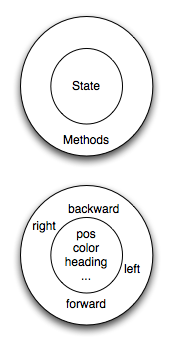3. Objects Revisited¶
In Python, every value is actually an object. Whether it be a turtle, a list, or even an integer, they are all objects. Programs manipulate those objects, either by performing computation with them or by asking them to perform methods.
You can think of an object as consisting of two things: an internal state, and a collection of methods that it can perform.
The state of an object represents those things that the object knows about itself. For example, as we have seen with turtle objects, each turtle has a state consisting of the turtle’s position, its color, its heading and so on.
The methods of an object are functions that allow you to change its state or ask questions about its state. Methods are like the actions that an object is able to do, or the questions that an object is able to answer about itself. For example, each turtle has the ability to go forward, backward, or turn right or left, via methods like .forward, .backward, etc. Each of these methods, when invoked, cause the turtle to change its internal state. Other methods, such as .position, don’t cause anything to change but simply return a value to report back to you some information about its current state. For example, if you invoke tess.position(), then the position() method will execute and return tess’s current position (i.e. the (x,y) coordinates of her location).
Individual turtles are different in that even though they are all turtles, they differ in the specific values of the individual state attributes (maybe they are in a different location or have a different heading).
